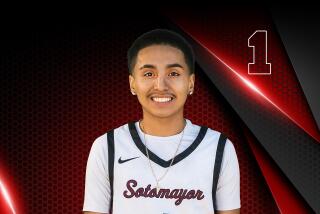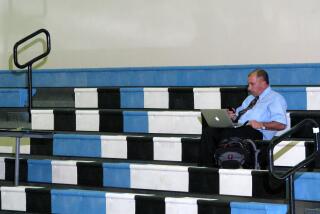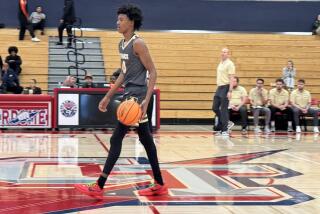AFFAIR OF THE HEART
LANCASTER — They were perhaps the cruelest words Trent Searcy of Antelope Valley High has ever heard. Words a teenager should never have to think about, especially an athlete whose heart belongs to basketball:
If you play basketball, you could pass out and die.
Those words from doctors will forever ring in Searcy’s ears. Words he wonders about every time he head-fakes a defender, whips the dribble around his back and drives to the basket in a pickup game at the local park.
Diagnosed with an irregular heartbeat after fainting in a fall workout at school, Searcy fears he will never be medically cleared to play the game he loves.
“No matter how bad I want to play, that’s the reality,” said Searcy, a senior who was expected to start at point guard for Antelope Valley. “I can either play and nothing will ever happen to me, or I can play and I might die.”
Doctors suspect Searcy has a heart condition known as exercise-induced ventricular tachycardia, a condition similar to the one that caused the death of All-American Hank Gathers of Loyola Marymount.
Ventricular tachycardia occurs when the heart beats too fast to pump blood, causing a drop in pressure, and, if sustained, a loss of consciousness. If the condition worsens it causes a quivering of the heart, which could lead to sudden death.
Gathers, who took medication to slow his rapid heartbeat, resumed playing after his condition was diagnosed. He passed out during a West Coast Conference tournament game at Loyola in March 1990 and died a few hours later.
Antelope Valley Coach Tom Mahan hasn’t allowed Searcy to practice with the team since the player fainted. Searcy’s parents also don’t want him to play.
“We’re pretty close and there’s only been a couple times when I’ve had to step in and be a father and tell him, ‘No,’ ” said Tony Searcy, Trent’s father. “And this is one of those times.”
Mahan, who has known Searcy for four years, feels just as strongly.
“I told [Trent], in my mind, you’re a kid I love and you’re not playing for me because I’m not going to take a chance,” Mahan said.
But Searcy’s heart problems haven’t kept him off the court. When he gets the itch to play, he calls his buddies to join him for a game at the park.
“He wants to play pickup games all the time,” said Steve Edwards, a teammate and close friend. “He wants to play so bad, he’d give anything to play basketball right now.”
That could be a fatal mistake, doctors say.
“The risk [of death] is greater than one in four,” said Dr. Charles Swerdlow, a cardiologist who provided Searcy with a second opinion. “In my mind, that’s too high a risk to recommend somebody go out and play sports.”
Swerdlow, who was one of Gathers’ cardiologists, said extensive tests would be necessary to conclusively determine if Searcy has a life-threatening heart condition.
Swerdlow said an irregular heartbeat, however, is enough to prevent Searcy from playing.
“We do not know if his heart is normal or if he has other abnormalities that we have not identified,” Swerdlow said. “The clinical implication is that if we did find an abnormality, he couldn’t play. And if we didn’t find an abnormality, he shouldn’t play.”
Meanwhile, Searcy’s buddies have become protective of their friend.
“We’re always asking Trent, ‘Are you OK?’ ” Edwards said. “It’s always me bugging him like I’m his mom. [But] he knows I’m concerned about him and he takes it.”
Edwards said he declines Searcy’s repeated requests to play basketball. But Searcy doesn’t need Edwards to play.
No one knows that better than Searcy’s family.
“The way he wants to play, I know he’s going to go out and play in pickup games,” Tony Searcy said. “I worry about that just about every day. I know deep in my heart he’s out there playing. . . He’s 18 and he thinks he’s invincible.”
Trent Searcy appeared unstoppable in the months leading up to the day he fainted.
After being declared academically ineligible and sitting out last season, Searcy worked hard in the spring and summer and had his game in top form, Mahan said.
In summer competition, Searcy was the Antelopes’ leading scorer, averaging 18 points.
“He was our best player,” Mahan said. “He’s an outstanding ball handler. He understands the game and gets the ball to the right player at the right time.
“He scores when he needs to and when there’s pressure, you put the ball in his hands [because] he’s going to take care of it.”
During conditioning drills late in the summer and early in the fall, Searcy experienced shortness of breath a few times, Mahan said. To help remedy the condition, which Mahan thought might be an allergy or respiratory problem, Searcy wore nose strips.
But running a mile in under eight minutes followed by a 20-minute intrasquad scrimmage were more than Searcy could handle.
Feeling weak, Searcy told Mahan he needed to sit down. Searcy headed to the bleachers, but passed out and hit his head on the bleachers. Edwards was the first to Searcy’s side.
“He knows I’m not the type to show emotion, but when that happened . . . I didn’t cry, but God knows I wanted to,” Edwards said.
Searcy regained consciousness and Mahan took him to the hospital. The doctor found nothing unusual and sent Searcy home.
Mahan wasn’t satisfied.
“I told him, ‘You’re not going to see the floor until we find somebody who knows what’s going on,’ ” Mahan said. “The kid’s life is way more important than basketball, obviously.”
Days of testing turned into six weeks--an eternity for Searcy, who wanted to get back to practice.
“I figured I would be back in a couple of weeks,” Searcy said. “But then [my doctor] kept sending me to another doctor and another doctor to take all of these tests. And it kept taking longer and longer. I just wanted them to hurry up and find something so I can play.”
A second opinion on his heart condition two weeks ago confirmed Searcy’s worst fear--he won’t be allowed to rejoin the team.
“It’s really upsetting,” Searcy said. “It’s hard for somebody like me who practiced and practiced just for my senior year, and [in] my senior year they tell me I can’t play.”
Searcy is still considered a member of the Antelope Valley team. He attends practice and sits on the bench for games.
“I still want to be there to help my friends out,” he said.
More to Read
Get our high school sports newsletter
Prep Rally is devoted to the SoCal high school sports experience, bringing you scores, stories and a behind-the-scenes look at what makes prep sports so popular.
You may occasionally receive promotional content from the Los Angeles Times.






